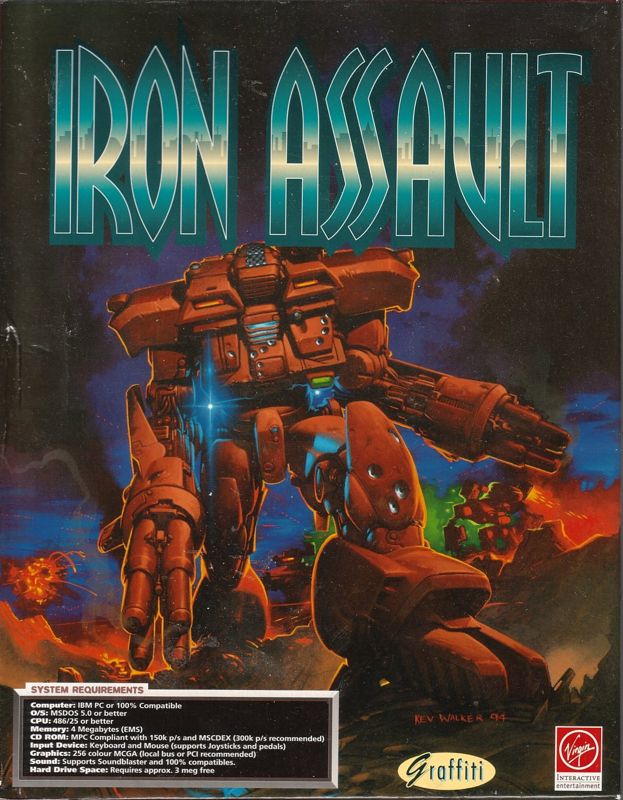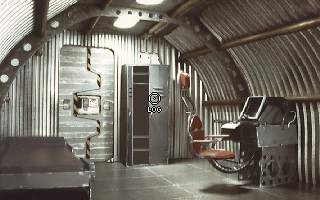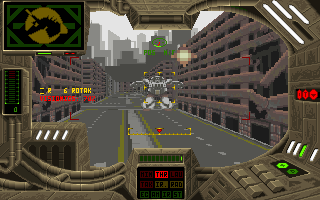Retro Replay Review
Gameplay
Iron Assault offers a streamlined approach to mech simulation, stripping away some of the complexity found in traditional titles while retaining core customization and tactical decision-making. Before each mission, you select from a range of giant combat robots and outfit them with weapons and support modules. This pre-mission loadout phase feels intuitive and quick, enabling you to adapt your strategy based on enemy composition or terrain without wading through overly detailed statistics.
(HEY YOU!! We hope you enjoy! We try not to run ads. So basically, this is a very expensive hobby running this site. Please consider joining us for updates, forums, and more. Network w/ us to make some cash or friends while retro gaming, and you can win some free retro games for posting. Okay, carry on 👍)
Once you launch into combat, controls prove surprisingly accessible. Movement, targeting, and firing can all be mastered in minutes, and even players who ignore advanced commands will find themselves capable of defeating most opponents. At the same time, mech veterans can dig a bit deeper—experimenting with energy management, weapon cooldowns, and defensive maneuvers—to eke out performance gains and tackle the toughest missions.
Missions themselves range from straightforward “destroy the convoy” objectives to more nuanced rescue or sabotage assignments. The partial destructibility of environments means you can punch through walls or topple streetlights to create cover or reveal hidden foes. These interactive elements keep engagements dynamic, encouraging improvisation rather than rote strategy.
Progression in Iron Assault feels rewarding without becoming grindy. As you complete assignments, you unlock new robot chassis and upgrade paths. This steady stream of options ensures that no two missions feel identical, and the sense of growth—both in firepower and pilot skill—persists from start to finish.
Graphics
Visually, Iron Assault employs a hybrid engine that marries a 3D terrain mesh with 2D sprite-based robots and effects. While it doesn’t deliver the full 3D polygons seen in later mech titles, this approach gives the game a distinctive, almost retro-futuristic charm. Urban landscapes, ruined factories, and desert wastelands each have their own color palette and layout, making every battlefield memorable.
Destructible elements such as lampposts, barricades, and sections of buildings react convincingly to missile strikes and heavy cannon fire. Though the physics are basic, the satisfaction of watching a static object crumble under your mech’s barrage is genuine. It adds a tactile dimension to firefights, reinforcing the power of your weapons and the weight of your robotic frame.
Perhaps the most eye-catching aspect is the series of stop-motion cutscenes that bookend key missions. Crafted from miniature models and filmed in classic stop motion, these vignettes evoke a level of handcrafted artistry rarely seen in computer games. They may show slight jitters or frame skips, but their novelty and nostalgia factor elevate Iron Assault’s presentation beyond typical pixel animations.
Performance is generally smooth on modest hardware, thanks to the simplified 3D engine. Load times remain brief, and frame rates hold up even during the most explosive set pieces. For players seeking a mech experience without the high-end graphics card demands of later sims, Iron Assault strikes a welcome balance.
Story
The narrative backdrop of Iron Assault unfolds in a near-future Earth at the close of the 21st century. Humanity has grown dependent on mega-corporations, which now wield absolute power, bending governments and militaries to their will. As society teeters on the brink of total enslavement, a ragtag resistance movement springs up—coalescing around the only hope left: piloting giant combat mechs against corporate war machines.
Storytelling is delivered primarily through mission briefings and the aforementioned stop-motion sequences. The writing strikes a classic tone, filled with calls to arms, betrayals, and last-ditch gambits. While the plot doesn’t delve into deep political intrigue or moral ambiguity, it provides just enough context to motivate each mission and underscore the stakes of robot-on-robot warfare.
Character development is limited, as the focus remains on the machines rather than their pilots. Brief radio chatter and occasional voiceover snippets hint at relationships and rivalries, but you won’t spend hours exploring backstories. Instead, the narrative drives you forward, mission by mission, with the promise of liberating humanity from corporate shackles.
Despite its simplicity, the story cleverly uses the futuristic Earth setting to introduce varied environments and enemy types. Desert oil rigs, snowbound research outposts, and smog-choked metropolis zones each tie into corporate interests, reinforcing the world-building even when the writing remains straightforward.
Overall Experience
Iron Assault excels as a “light” mech simulator, offering just enough depth to satisfy fans of the genre without overwhelming newcomers. Its mission-based structure, accessible controls, and steady progression make it easy to pick up and hard to put down. You’ll find yourself experimenting with new loadouts and revisiting earlier stages with upgraded hardware, eager to see how different tactics play out.
The graphics and stop-motion cutscenes lend the game a unique visual identity that stands apart from the polygon-heavy contemporaries. This stylistic choice, paired with destructible environments, gives each engagement a sense of tangible impact. The performance-friendly engine also means that Iron Assault runs smoothly on a wide range of systems, extending its appeal to budget-conscious players.
While the story remains more of a backdrop than a deep narrative journey, it effectively motivates your fight against global corporate tyranny. The lack of extensive character arcs may disappoint those seeking a cinematic epic, but the focus on mech combat ensures that the action always takes center stage.
All told, Iron Assault is a compelling package for both mech aficionados and players curious about piloting giant robots without a steep learning curve. Its balance of accessibility, distinctive graphics, and handcrafted cutscenes deliver a memorable experience that stands the test of time. Whether you’re a veteran of MechWarrior or a newcomer lured by the promise of giant metal behemoths, Iron Assault is well worth your attention.
 Retro Replay Retro Replay gaming reviews, news, emulation, geek stuff and more!
Retro Replay Retro Replay gaming reviews, news, emulation, geek stuff and more!









Reviews
There are no reviews yet.